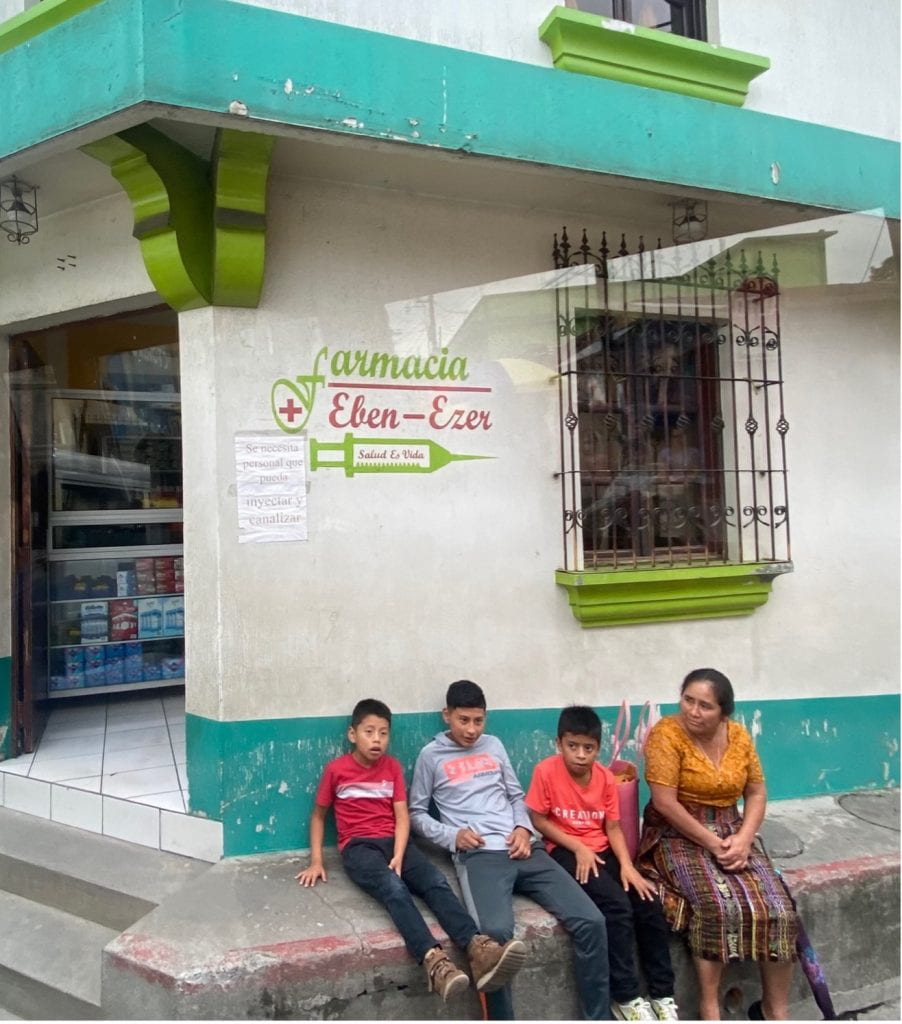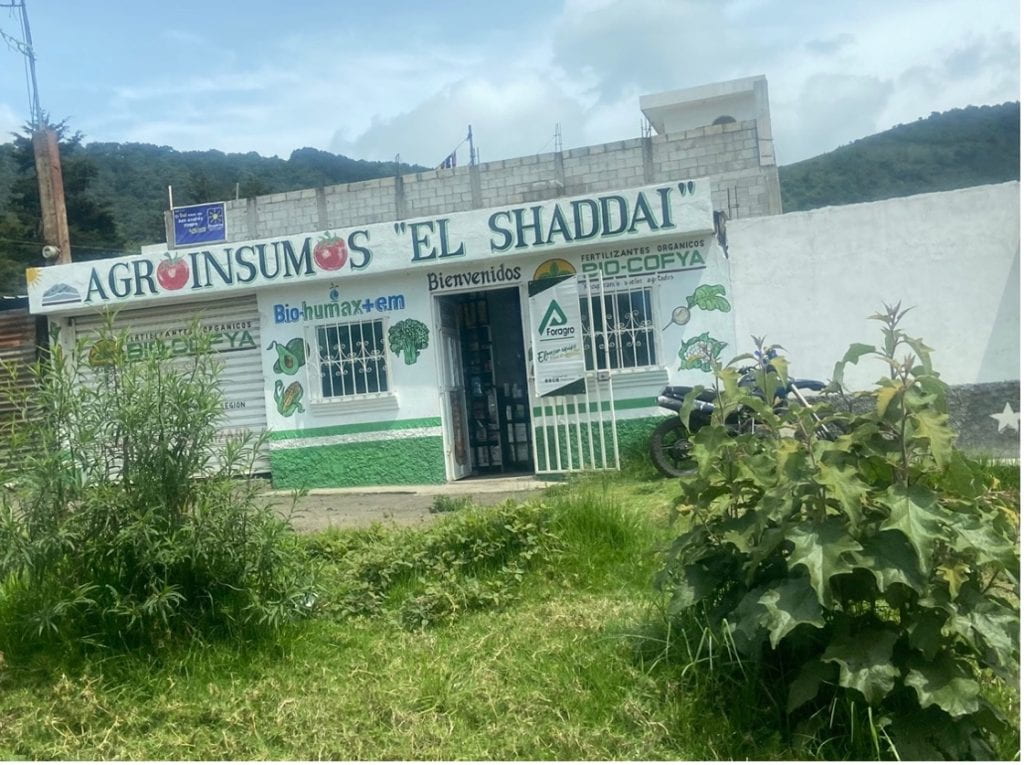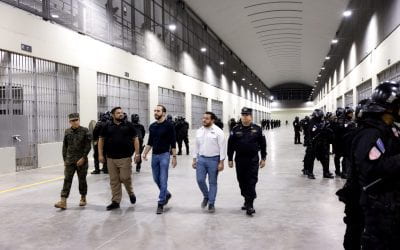Menorahs in Unlikely Places
Guatemala Journal

The Chabad Menorah atop the famed volcano greets visitors to the wonderful Chabad of Antigua run with love by the dynamic couple, Rabbi Chaim Silber and his wife Daria.
Everywhere we went in Guatemala, we saw shops with Hebrew names—Eben Ezra Pharmacy, El Shadday Fertilizer.

But it’s not because these Guatemalan entrepreneurs are Jewish. We also saw the Hosanna Funeraria Cristiana adorned with a menorah, the seven branched candelabra that illuminated the Temple of Jerusalem and one of the most enduring Jewsh symbols, and a Christian school called Beth Shalom, the House of Peace. When a group of Yalmulke-wearing students were walking back to the hotel Friday night, some late-night revelers greeted them with cheers of “que viva Israel”! There are about 1,500 Jews in all of Guatemala which makes this embrace of Jews and Jewish symbols all the more remarkable.
As a professor specializing in Sephardic History at Yeshiva University (YU), an orthodox Jewish college in New York City, I was immediately drawn to the layers of meaning behind these Judaic symbols. I have spent time throughout the Iberian world but it was my first time in Guatemala. I was there with a group of undergraduates from Yeshiva University led by my intrepid colleague, Rabbi Daniel Coleman. We learned a lot, made powerful connections with the open-hearted people we met and left with many questions and a deeper curiosity about Guatemalan society and culture. Throughout our journey, we encountered a fascinating interplay between people’s faith, identity and the varied ways they navigate their place in the world. We found precious vestiges of a Jewish past but also surprising examples of a vibrant Jewish present. I was constantly musing on what these surprising Jewish elements can and cannot tell us about religion, identity, Jews and Judaism in our ever-unfolding, interconnected world.

While Guatemala is majority Catholic, there is a strong evangelical presence with influential government and cultural figures openly declaring their Christian, i.e. non-Catholic bonafides. When I asked devout evangelicals in Guatemala about these Biblical references they explained that they invoke these Hebrew terms because they take God’s promise to Abraham in Genesis very seriously: ‘And whoever shall bless you shall be blessed . . .’ Attachment to the Jews and Judaism is a blessing (“La bendición” was another popular store name.) The connection to the modern state of Israel has a deep history for this small nation. Jorge García Granados, a prominent Guatemalan politician, penned a passionate defense of the Jewish right to national self-determination when he was a member of the UN High Commission on Palestine. Guatemala was the second nation to vote in favor of the creation of the Jewish state and it was the first nation to actually move its embassy to Jerusalem following the U.S. decision to do so. So the connection to Hebrew and Jewish symbolism is not only a biblical connection, it has real world political implications as well. Traces of Judaism not only permeate Guatemala’s evangelical community; they are present in Catholic icons as well.
Hiding in Plain Sight
The vestibule of the northern entrance of the great church of St. Francis in Antigua de Guatemala is framed by four retablos dedicated to different saints, adorned with flying angels announcing the good news. Small plaques on the sides of the installations indicate the burial place of different saintly members of the Franciscan order who preached and served in Guatemala. The bottom row of each installation had a series of images from the Temple such as the menorah and the ark of the covenant. There was also the Tablets of the Ten Commandments, a six-pointed star along with the classic Franciscan symbol of a cross with two outstretched arms revealing the stigmata in the center. One might be tempted to see a secret Jewish past hiding in plain sight. Were these Franciscans secretly committed to the Judaism of their secretly Jewish converso (Jews who converted to Catholicism under duress during the Spanish Inquisition) ancestors?
The Catholic Church is born out of the matrix of Judaism. It sees itself as a new Israel, superseding yet embracing and transforming the symbols and ideals of the “Dead law of Moses”, the carnal law of Israel is triumphantly replaced by the renewed spirit of the Savior sacrificed on the cross. My good friend Steven Fine ( who literally wrote the book on the Menorah!) has shown how the menorah, in particular, played a prominent role in this Christianization of Jewish iconography and religious self-conception. Along with borrowings of the priestly garb for the priests of the new Ecclesia, churches would prominently display seven branched candelabras, strengthening the aesthetic connection between their new churches and the superseded temple of Jerusalem.While the menorah is obviously a Jewish symbol, it is also a deeply Christian one, one that trades in the Church’s claim of spiritual triumph over the Jews.

The Franciscan cross with the stigmata of Christ is flanked by the Tablets of the Law brought down from Mt. Sinai by Moses and the Menorah that illuminated the inner sanctum of the Temple. All of these images are framed by an eruption of tropical Baroque flowers and vines.



The arc of the covenant containing the tablets of the Ten Commandments. This was the holiest object in the Temple and it was placed in the inner sanctum.
How do these Temple images function within these works of devotional art and how do they interact with the spiritual drama of the saints featured above them? The retablos focus on the Virgin Mary depicted both as a celestial queen and as the Virgin of Guadalupe—the beloved mestiza Virgin found on every Mexican pick-up truck in Texas and in any self-respecting taqueria! The other two panels are dedicated to San Joaquin and Santa Ana, Mary’s saintly parents. The interplay between the temple imagery and the figure of Mary and her parents, highlights the transition from Israel of the flesh to Israel of the spirit. Mary and her family are the transition point between Carnal Israel, the Jews of flesh and bone who were God’s chosen and the transition to the New Israel, the spiritual chosen of the Lord.
In the years following his own conversion to Christianity the 14th century scholar, financier and courtier rabbi, Shlomo Halevi of Burgos, who after his conversion became the Bishop Pablo de Santa Maria, argued that Jewish converts to Christianity had an advantage over Old Christians because they not only partook of the spirit of Christ, but also of the flesh and blood of Mary. This astounding and counterintuitive idea embraces the power of spiritual liberation that the Church promised its faithful while maintaining an attachment to the earthly roots of the new faith. Could it be that a group of Franciscans with converso origins came to the new world and might have found solace in this religious vision– a way to mediate between their Catholic faith and the weight of their Jewish blood?
I reached out to Elizabeth Bell, a local historian and guide living in Guatemala for decades. She told me that according to interviews she conducted in the 70’s, these retablos were not destroyed in the earthquakes that did cause major damage to the church, they were redone in the middle of the 20th century probably based on an earlier design. The use of the Jewish star clearly points to a more modern inspiration for this artist because the star/Magen David was not a prominent Jewish symbol until the 18th-19th century. There are plenty of unanswered questions here, but I think it is a testament to the complex ways that the Church’s conceptual encounter and appropriation of Jewish ideas and symbols is complicated and often resisted by the very nature of Christianity, specifically its debt to the Jews of flesh and bone and spirit that they thought they had superseded.
How would this dialectic of spirit and flesh, of the weight of blood and race versus the power of spiritual transformation play out in a place where the indigenous population was so thoroughly conquered and shattered in political and military terms but where the culture, language and religious beliefs of the majority of the people resisted easy conversion to the Good News?
Community and Converts
Hebrew place names and tropical menorahs abound in this Central American country. But there is, at least for me, a deeper way that Judaism lives and breathes in Guatemala, and that’s both in the actual well-established Jewish community and in a surprising group of newer converts. The Jewish community in Guatemala dates back to the earliest German immigrants following the coffee boom of the 1870’s. It was nourished by the waves of immigration following the dissolution of the Ottoman Empire, then by the chaos of the aftermath of World War I and of those fleeing before and after the Holocaust. Our group spent a beautiful and spirited Sabbath hosted by this small but dedicated community in downtown Guatemala City. When the sabbath ended, we traveled to a lovely gated community of mid-size homes armed with 20 boxes of kosher pizza. We arrived at Kahal Kadosh Shaar Hashamaim, (the Holy Community, the Gates of Heaven), a community of 12 families who all found their way to Judaism after long, winding roads in search of a deeper religious truth. These families were all raised as faithful Christians (mostly evangelical) and their study of the Bible left them with unanswered questions. While searching online they found some answers to these questions in Judaism and they also found each other. As they went deeper into learning and living according to Jewish traditions, they decided to buy a house that they would share as their Shabbat space. Each family has a small, dorm-like room. They prepare meals together, generally bringing the food before Friday evening and they pray and study together in the small synagogue they have lovingly fashioned with a stunning, hand-carved Torah ark and the raised platform used for communal reading of the Torah scroll known as a bima or teba.

The Tablets of the Ten Commandments with the initial Hebrew words for each of the ten. The curved tablets and the heraldic lions are rather common throughout Ashkenazi synagogue art.

The Tree of Life motif on the door of the ark holding the Torah Scrolls with the seven sacred fruits of the Holy Land on the sides. These are all crafted from the majestic local mahogany trees.
The group proudly gave us a tour of their well-designed community center—their ritual bath (mikveh), the kitchen, the patio that serves as a place for holiday and sabbath meals and even their personal living spaces.I met Manuel; we spoke of his spiritual journey and of his hopes for his children. We heard from some of the younger members of the community who told us of the social and emotional challenges of being Jewish. They reflected on the difficult social space they inhabit, “We are no longer welcomed from where we came, and we do not have many fellow Jews to share this with.” Their children all go to schools where they are the only Jewish students so they have no other religiously observant friends. The children learn everything about Judaism from their parents. They discussed how hard it was for their families to understand and accept their new path but that over time it has gotten better- their families make sure to not plan events on Saturdays, and they know they can’t expect a call back until Saturday night.
Manuel’s daughter was studying at the Latin American program at Midreshet Lindenbaum in Jerusalem, the same religious seminary where my daughter is studying— they have not found each other yet but I am excited for them to meet. When speaking with Fernando, the president of the community, I asked if the kids would appreciate Zoom classes in basic Hebrew taught by one of our Spanish speaking undergrads. This is a project we are in the process of getting off the ground.
I study conversion, I read conversion narratives and study complex cases of religious transformation from long ago, and I still see so much mystery in the decision to convert; the rational arguments for one religion over another have intellectual value, but, I do not believe they actually change anyone’s mind or drive someone to embrace a foreign religion. Spending time with these “New Jews” reminded me of that mystery. I was struck by their sincerity and the depth of their commitment to the search for the truth. Hearing their stories, I was struck by the power of radical self-fashioning at the heart of conversion. As our trip continued we saw that there were more than one group of Guatemalans who were searching for Jewish answers to their Christian questions.
Un Satmar super-Guate!!
After a long day of visiting innovative health clinics and schools we gathered for dinner at the Chabbad center of Antigua. Housed in a beautifully restored colonial home with gardens and tiled floors and fountains, the Chabbad center welcomes people looking for a kosher meal and sabbath services in the historic center of Antigua. As we sat down, we noticed that we had some guests: two couples with small children. They were dressed in the long coats and black hats and long skirts and head coverings typical of the Satmar Hasidic group. A look that would not be out of place in parts of Brooklyn but stood out here in Guatemala. As we finished our meal we were introduced to these two families, both recent converts to Judaism, who through an unlikely turn of events embraced the religious world of the Satmar Chassidim, a group of deeply devout Jews based in New York. Satmar, has roots in pre-war Hungary, and the current members of the group passionately hold on to a traditional lifestyle, eschewing secular education, maintaining distinctive dress and hairstyles and embracing Yiddish as their main internal language. We were wondering how these young Guatemalans found their way into the world of Hungarian Hassidim. After dinner, Yosef Aharon and Yisroel Meir told us their stories. I was honored with the task of translating for them. As I began to share their story with the group, expanding, clarifying and checking in with them as I translated their words, I was overcome with emotion. I had to work hard to stay focused on their story and not let its emotional power break my heart a little bit. I was humbled and inspired by their tenacity and by the purity of their search for a deeper religious truth.
They explained that they both came out of “Messianic” churches, evangelical congregations that celebrated the Jewishness of Jesus, embracing certain classic Old Testament practices such as keeping the Sabbath on Saturdays and avoiding pork. But Yosef Aharon felt there was something missing from his religious life, that there was more out there, a deeper truth. He encountered a rabbi from a small group of Satmar Hasidim living in Guatemala at the time. This rabbi helped him with his doubts, and he eventually began his path to conversion. Yosef Aharon said in a mixture of Yiddish, English and Spanish, that he and his friend Yisroel Mayer (they met in a rock band) dress like Satmar Hassidim- long black coats, broad brimmed black hats– despite Guatemala’s tropical climate, because Satmar welcomed them despite their evangelical past. Their Satmar friends from New York look after them, they sponsored their daughters’ studies in Israel at a seminary for Latina students and they have felt true and lasting kinship.

Fast friends: the author with Yisroel Mayer
While Tzipoira spent most of the night watching her rambunctious and adorable small children, Nejama was happy to share her experience, the challenges of navigating the relationship with their families and friends who saw their conversion as a rejection. She discussed what it was like going to work at a FedEx call center dressed like a chassidishe woman and how the distinct dress allowed her to explain her new religious path. She spoke confidently in English about how her coworkers began to understand her transformation and come to respect her choices.

Nejama sharing her story with our group.
In response to students’ questions, Yosef Aharon described his family’s reaction to his embrace of Judaism:
“My father was so furious with my decision that he punched me. But later he saw what it meant to me and why it was important for me. He told my brother once, many years later, that actually we are descendant from Jews.”
Yosef Aharon explained that it was well-known that the area around Antigua was a place where many Conversos (Jews who had converted to Catholicism in late medieval Spain) settled during the colonial period. His father never shared this piece of family lore with him directly, but he took the fact that his father shared this with his brother as a possible sign of approval or at least begrudging understanding of his decision to convert.
The communities that we encountered explained their conversion as the natural progression towards a deeper religious truth. But vague references to a possible Jewish past, to roving crypto-Jews who settled in the mountains and valleys of Guatemala and who might have passed down vestiges, still-hot embers of Judaism to their descendants, adds an allure and a sense of grounding to their journeys. While these individuals embraced Judaism out of a deep sense of faith, notions of a possible Jewish past made the journey into a new religion seem like a homecoming of sorts.
Tropical Menorahs
Throughout my time in Guatemala, I was struck by the beauty and spiritual power of actual Jewish menorahs and other objects of devotional art. I already mentioned the Torah Ark at Shaar Hashamaim, with its elegant engravings celebrating the Torah as a tree of life, flanked by the sacred fruits of the land of Israel. The tree with its deep roots was evocative of the ceiba trees we encountered throughout the countryside, those massive, ancient trees that evoke a sense of cosmic rootedness. That Torah ark was made with great care by a woodworker from Antigua under the careful direction of community leaders.
On our first morning we prayed at Magen David, the synagogue founded by Jews who came from the Middle East—from Syria and Turkey, the land of Israel and Morocco, with Arabic, Spanish and Hebrew names like Mizrahi, Behar, Sabbagh. This was the first official synagogue built in Guatemala in 1924, it is far from the main area where Jews now live and is not used regularly. A few members of this original community joined us graciously for morning prayers. The Neo-Moorish architecture of this stately building evokes the Middle Eastern origins of this community and proudly proclaims their otherness to their new neighbors. In addition to the Moorish style arches and columns, the original windows utilize the sort of geometrical patterns common in Islamic aesthetics. Felix Cohen, whose father was the president of the synagogue for many years, explained that they didn’t want the lines of the stained-glass panels to inadvertently form a cross so they opted for these geometric arabesques. In these small details you see the anxiety of a small community in a strange, welcoming new land. They want their children to remember and be proud of their origins. But you also see their love and dedication to beautifying this sacred space.

The building is not meant to blend in. Inside, the layout follows the classic Sephardic organization of seats facing the tebah, the central desk for Torah reading and a long space between the tebah and the hehal, the Torah ark. The doors to the hehal are flanked by a Guatemalan and an Israeli flag. To the far left there is a large Chanukah Menorah. It is carved from the deep brown mahogany so often used in Guatemala, known locally as caoba. While the menorah follows the common structure of a curved candelabra, it is adorned with tropical flora.



At the main synagogue in Guatemala City’s business district I found a different negotiation of tradition and tropical modernism. In back of the modern Torah ark there is an older one, placed to the side that houses extra Torah scrolls. It is an exquisite mash-up of classic Ashkenazi iconography wrapped in full tropical flair. We see a crown of the Torah with an eagle, but the adorning flowers reflect the wild sensuality of the tropical forest.


I was particularly moved by all of these small yet essential aesthetic choices. The use of local but precious materials. The direction given to the local craftsmen and their own creative contribution. The synagogue president can ask the carpenter to use lions, branches and flowers, but he can’t tell him how to shape the wood into those figures. Jews in new environments hold on to their past, recreate holy spaces that evoke the synagogues of their hometowns back in the old country, but they bring their own needs and tastes into the crafting of that space. These are small acts of love, love of one’s ancestors and of one’s new home.
I left Guatemala with more questions than answers, and more impressions than insights. I was struck by the layers of culture, the erasures, the resistance and perseverance of so many people both holding on to their culture and recreating it. I saw it in the pride of the street vendors in their wares, the tenacity of the teachers and doctors and nurses in the clinics and schools we visited. I heard it in the variety of Mayan languages still spoken in Guatemala and in the religious passion and creativity of these tiny Jewish communities.
Ronnie Perelis has the honor and pleasure of teaching and researching about the Sephardim and the Jews of Latin America and much more at Yeshiva University in New York City. He is also the director of the Rabbi Arthur Schneier Program in International Affairs at YU where he runs the Diasporas Project which focuses on how distinct cultures and communities connect across borders. He lives in Teaneck, New Jersey with his wife and children and he loves exploring the world, face to face.
Related Articles
Haiti: A Gangster’s Paradise
Haiti is in the news. In recent weeks, gangs have coordinated violent actions, taken to the streets and liberated thousands of inmates to spread chaos and solidify their control of the Port-au-Prince capital.
Crime and Punishment in the Americas
As 2024 ushered in, newly-elected Ecuadorian President Daniel Noboa issued a state of emergency in his country, citing a wave of gang violence spurred by the prison escape of a local criminal leader with ties to Mexico’s ruthless Sinaloa Cartel.
Women CEOs in Latin America: Overcoming obstacles, navigating through challenges
I first arrived in Latin America in 1997, and since then, I’ve been involved in education and the development of leadership and governance issues in the region. During these 27 years—12 of them from Spain—I have had the opportunity to interact with leaders from the region, the private and public sectors, multinationals and small and medium-sized enterprises, and various industries.




